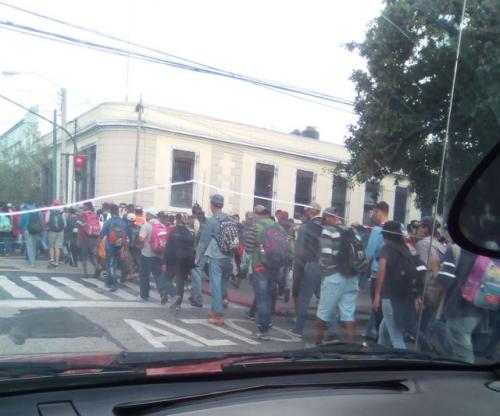The Central American migrant exodus: Between exile and forced migration
- Opinión

... Only in an upside down and indifferent world, like the one we live in, forced migrants, exiles from home and a decent life in the home, are criminalized and treated as criminals ... And, only in an unjust and ruthless world, the executioner disguises himself as a victim and criminalizes the excluded ...
Urban Arbide, August 2017.
For the Chirihue Balderrama, thinking that the world can (and above all must) be a fairer place ....
Central Americans, excluded and exiled
Contrary to what is reported and misinformed by certain media, the thousands of Central Americans, who for weeks and months entered and transit through Mexico to try to cross into the US, are not criminals. These are people and families in situations of high vulnerability, who had to leave their homes and their countries of origin because their living conditions were very adverse. As various specialists and pro-migrant groups have pointed out, there are mainly two motivations that have incited (or forced) these Central Americans to migrate.
On the one hand, the very low levels of socioeconomic development, which are manifested in the high unemployment rates, the very low and insufficient salaries and the persistence and growth of extreme poverty. These processes of deterioration in people's material living conditions have been accentuated in recent years, mainly due to free market policies and structural reforms dictated (imposed) by US interventionism and certain international organizations (IDB, IMF, BM). Particularly in Central America, regional economic integration and inequitable insertion in neoliberal globalization have only increased inequality and fostered a growing and very selective accumulation of wealth (in very few hands); with the consequent correlate of an accelerated process of increasing poverty and extreme poverty; a great majority of impoverished people thrown into precariousness.
The other great motor that has caused forced migration has to do with the conditions of structural and generalized violence (phenomena such as gangs, organized crime, among other criminal groups), which put the safety and life of thousands at risk on a daily basis of people in the region.
The circle of poverty and violence
In this sense, the most accentuated case of the relationship between poverty, violence and non-regular involuntary migration is Honduras. In recent years, this country has had one of the highest rates of violence, murder and crime in the continent and the world. According to UN agencies and certain specialists, in the last decade there have been more than 70,000 murders in that country, which places Honduras in a situation similar to that of countries in conditions of armed conflict. In addition, in Honduras the gap between extreme poverty and exorbitant wealth has increased dramatically, particularly since the coup d'état and the overthrow of the Zelaya government (with the endorsement of the US). The Honduran State and its institutions are completely overwhelmed and are incapable (among other things due to lack of political will) of generating the essential living conditions for the great majority of Hondurans. In fact, some specialists in the subject point out that about 70% of the population of that country wants to leave Honduras. The context of the other two countries of the northern triangle of Central America is not much better. El Salvador also has very high levels of insecurity and violence, as well as alarming levels of poverty. And the situation in Guatemala is not substantially better.
Discrimination as a migratory control strategy
The Central Americans are not delinquents; on the contrary, they are exiles who flee from the poverty and violence they suffer in their places of origin. They escape from their homes and communities because the future is not possible and the present is too adverse. In this context, the discrimination of certain news media and the US government is based on a stigmatized and fictitious image (which does not correspond to the reality) of these Central Americans. This image is created, deliberately and / or implicitly, with the political and ideological aims of containing and controlling forced migration. By denying them or not recognizing their status as forced migrants (and possible refugees), their right to asylum is canceled and violated, which by law would give them the possibility of recourse.
- Guillermo Castillo, professor at the UNAM, México.
http://unam.academia.edu/GuillermoCastilloRamirez
https://www.researchgate.net/profile/Guillermo_Castillo_Ramirez
Del mismo autor
- Forced internal displacement in Mexico and processes of violence 13/03/2022
- Labor struggles against precarious work and agribusiness exploitation 09/01/2022
- Detentions, deportations, and criminalization of migrants 29/11/2021
- México: detenciones, deportaciones y criminalización de los migrantes 15/11/2021
- Visibility of migrant voices and subjects 18/10/2021
- La decolonialidad y el abordaje de las movilidades humanas transfronterizas 01/10/2021
- Migrants, social organizations, and policies to control cross-border mobility 20/09/2021
- Decoloniality and sense of the production of social knowledge 06/09/2021
- Decolonialidad y sentido de la producción de conocimiento social 26/08/2021
- México: migrantes, organizaciones sociales y políticas del control de las movilidades transfronterizas 09/08/2021








